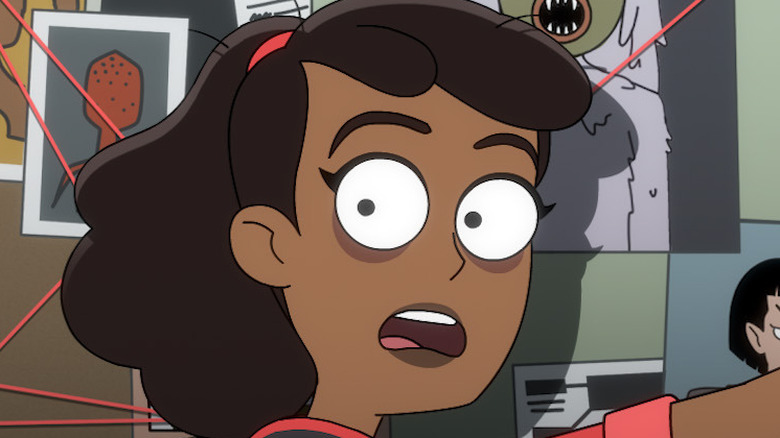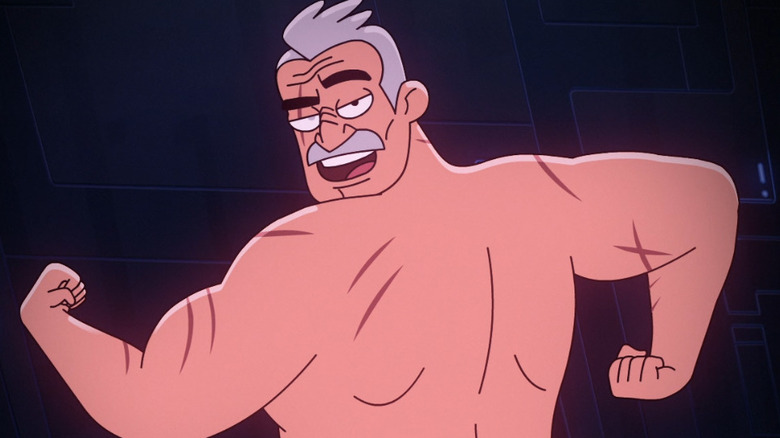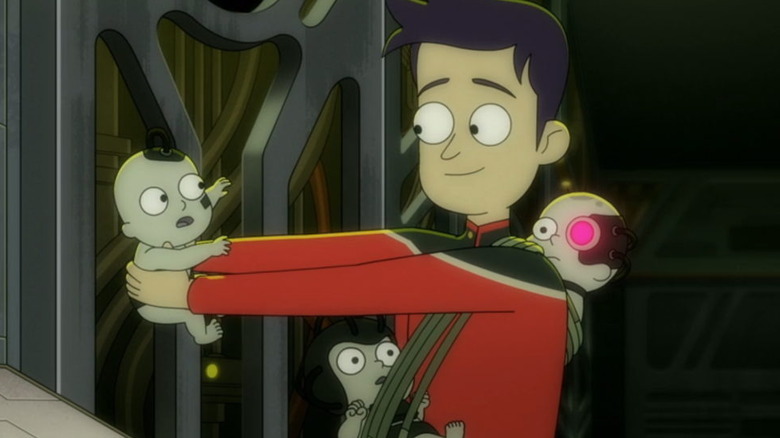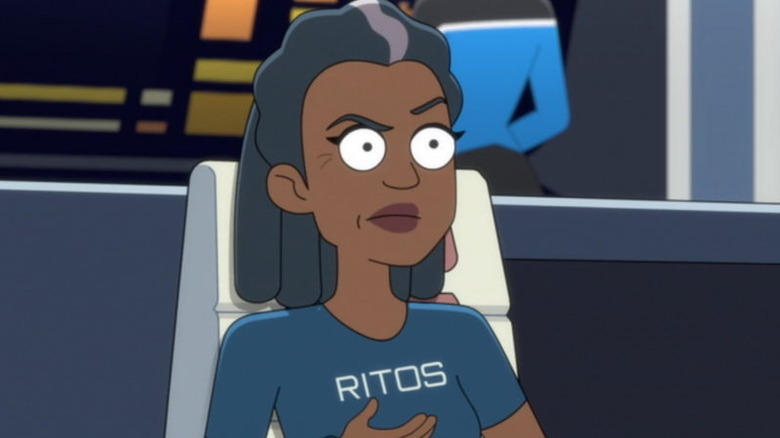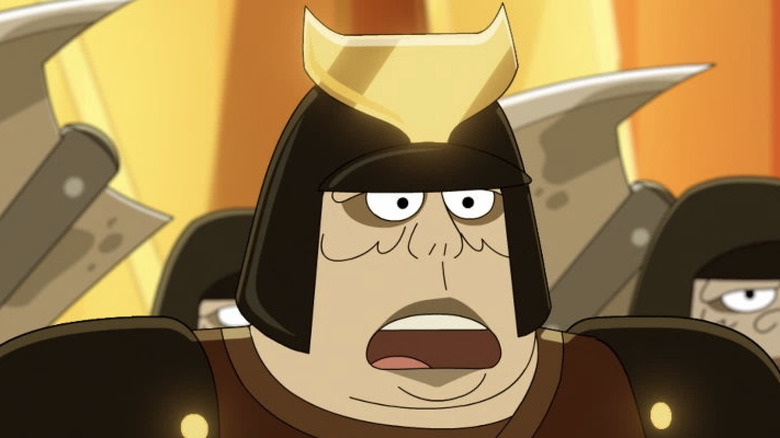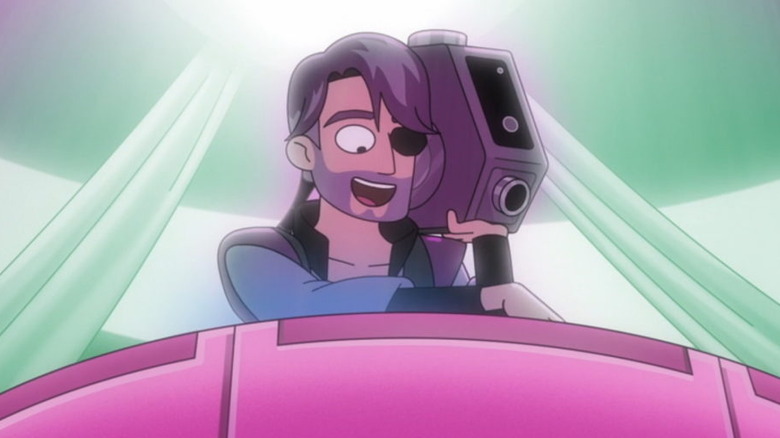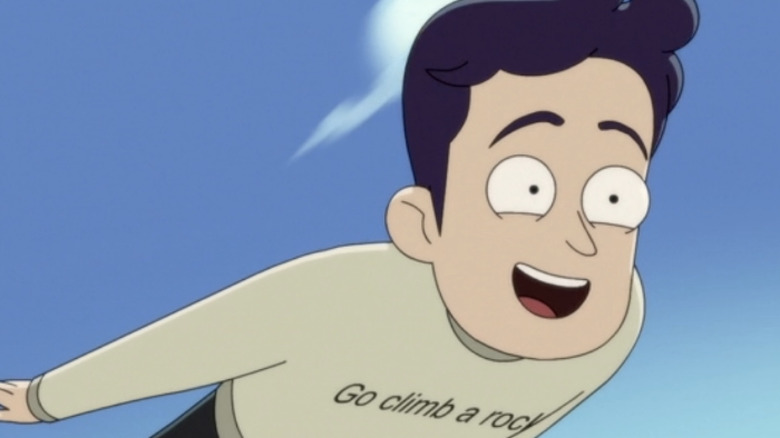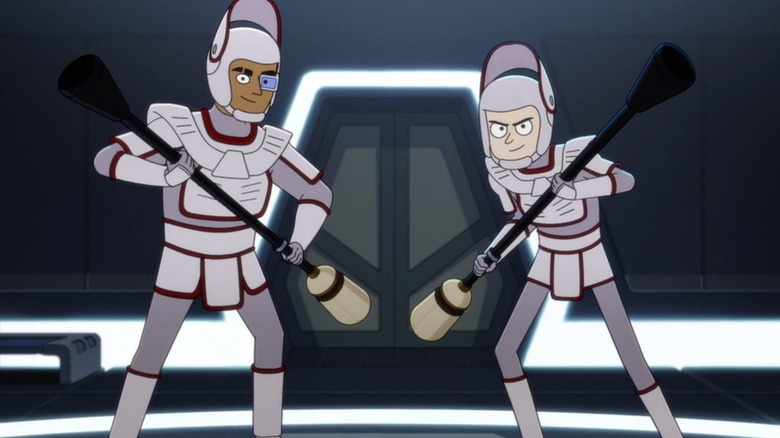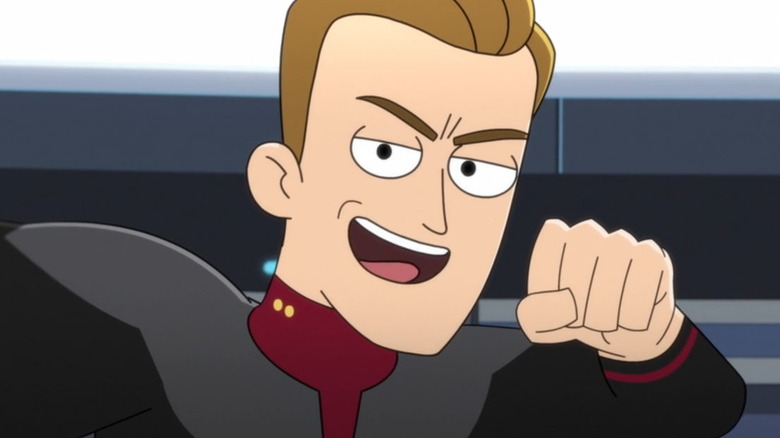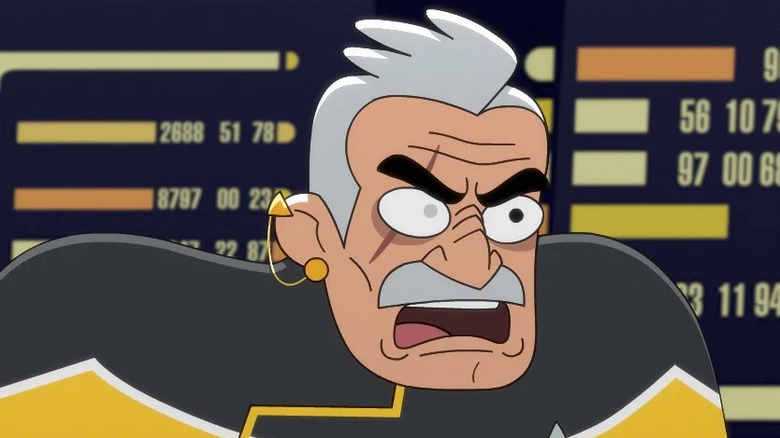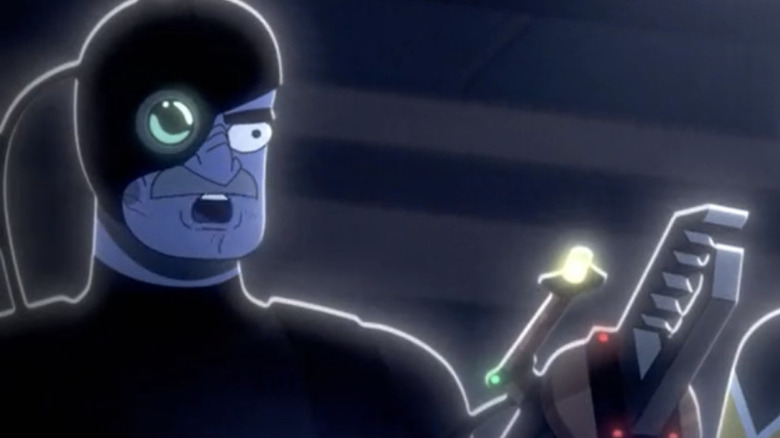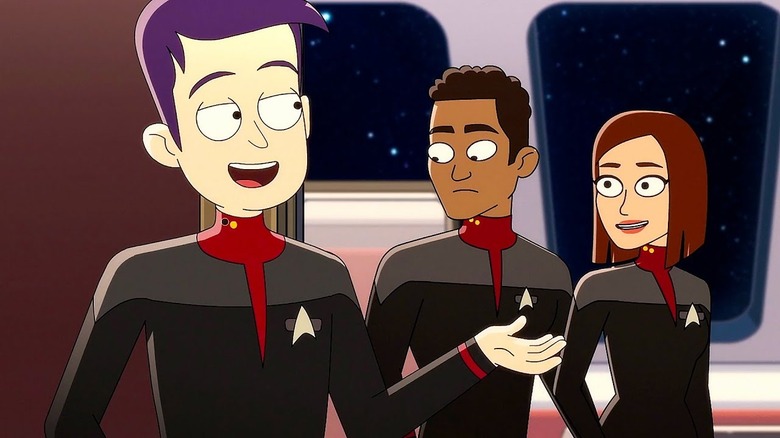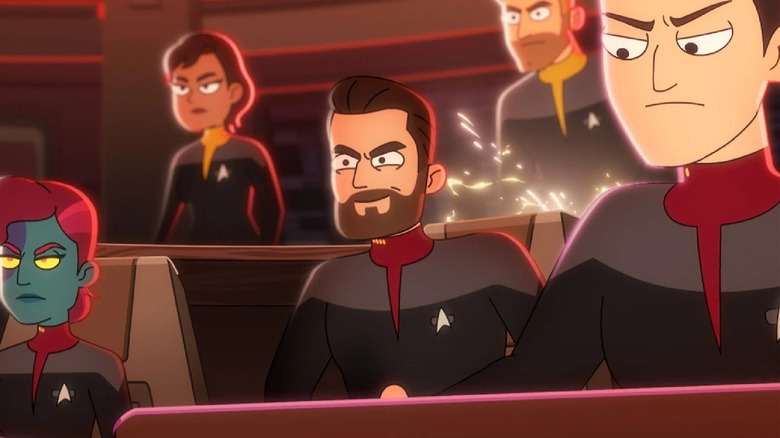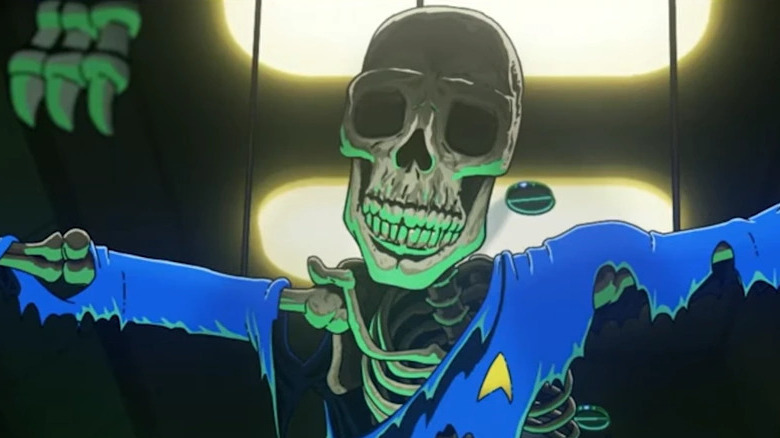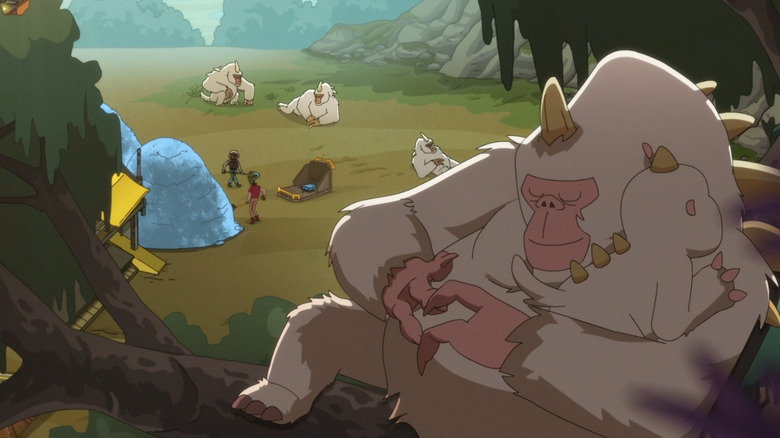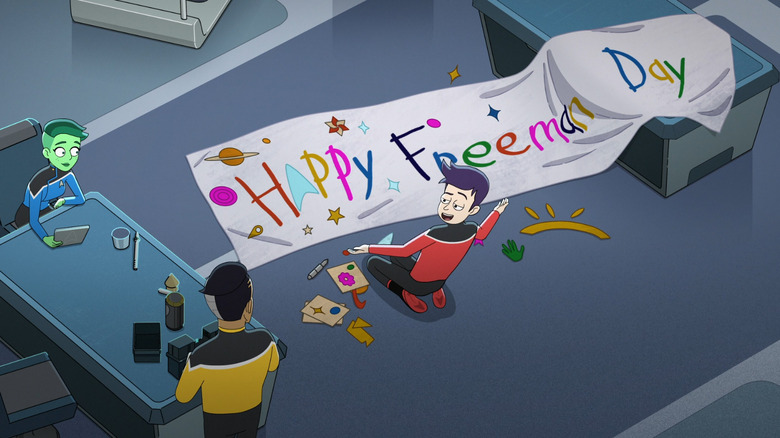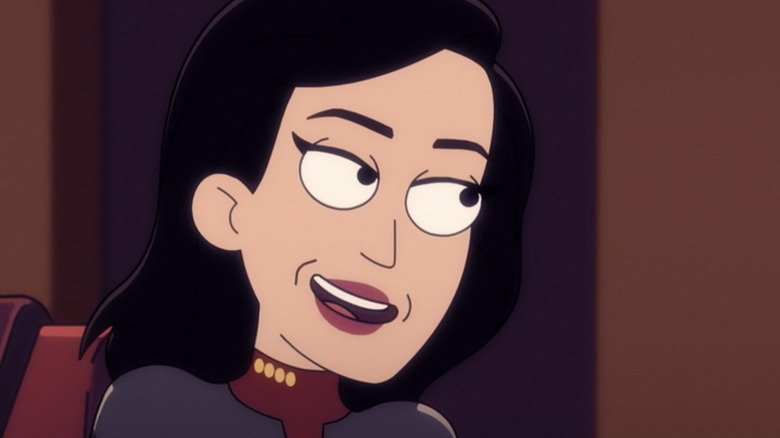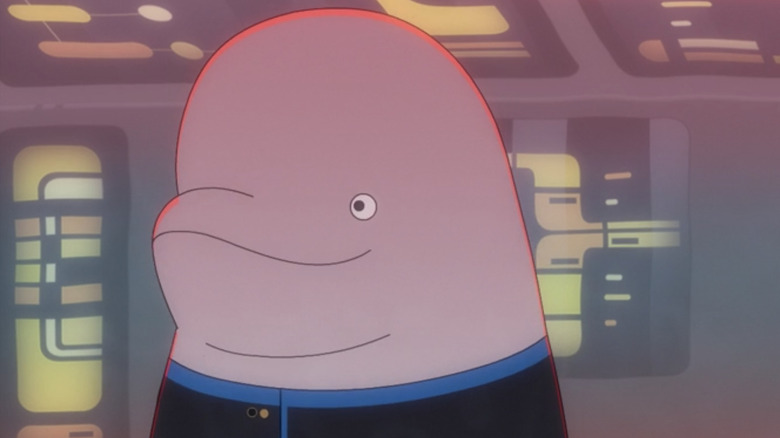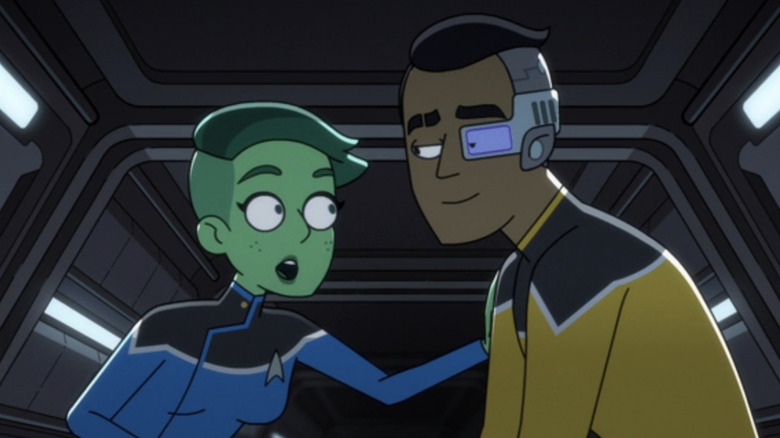Best Easter Eggs In Star Trek: Lower Decks Season 2
Mike McMahan, creator of "Star Trek: Lower Decks" has proven himself to be as big a Trekkie as anyone. Every episode of the hilarious show is littered with callbacks, references, and Easter eggs even the most devoted fans might struggle to recognize. Season 1 ushers viewers in with a wide variety of nods. Some are subtle, like when Ensign Mariner uses Captain Kirk's famous double-handed chop to take down an Andorian in "Envoys." Some are overt, like when immortal trickster Q challenges the bridge crew to a duel at the tail end of "Veritas." Every single one of them is delightful.
Season 2 of "Star Trek: Lower Decks" takes the series to new heights of character development, worldbuilding, and storytelling. It's also just as jam-packed with in-jokes as Season 1, and we're here to document the highlights. From references to real-world production hiccups to dizzyingly obscure character details, these are the best Easter eggs from "Star Trek: Lower Decks" Season 2.
The Naked Time
In "I, Excretus," a Starfleet drill instructor puts the Cerritos crew through a series of tests and training exercises. Ensign Mariner is tasked with completing a drill called "The Naked Time," in which she must save a crew infected with a deadly virus that takes away their inhibitions. Effectively, this turns the crew into a band of drunken party-goers. Of course, Trekkies have seen this virus before in two separate episodes. The first, "The Naked Time," is a classic from Season 1 of "Star Trek: The Original Series." The second is "The Naked Now," which aired more than 20 years later as part of Season 1 of "Star Trek: The Next Generation." Mariner's brief test references both episodes: She encounters graffiti seen in "The Naked Time," and discovers members of the ship's crew carousing in the buff, much like Geordi does in "The Naked Now."
It's funny enough to realize that Starfleet has taken the events of those episodes and turned them into a drill Starfleet officers must pass, but the cherry on top arrives when Lieutenant Shaxs referentially shouts, "It's naked time!" Sharp-eyed fans will also notice Lieutenant Commander Steve Stevens is seen holding a "horga'hn," a Risian fertility idol from the "Star Trek: TNG" episode "Captain's Holiday."
Boimer gets assimilated by the Borg
"I, Excretus" sees Boimler trying his hand at a drill called "Borg Encounter," in which he must escape a Borg cube. His first attempt to pass the test references the Borg's first-ever appearance in the "Star Trek: TNG" episode "Q Who" by revisiting the drawer-style incubator that houses Borg babies. This ridiculous contraption hasn't been seen since that 1989 installment, making its return a truly hilarious Easter egg.
"I, Excretus" also gives us our first sight of the Borg Queen since she last appeared in the "Star Trek: Voyager" finale, "Endgame." Original actress Alice Krige even returns to voice her, which is a nice touch. The episode also references the classic "Star Trek: TNG" two-parter "The Best Of Both Worlds," which features the iconic reveal of Picard's Borg identity, Locutus of Borg. Not only does "I, Excretus" use that episode's musical cues, it echoes Locutus' infamous laser-eye-glint when Boimler emerges as "Excretus of Borg". Finally, when Boimler emerges from the simulation, he says, "They took everything that I was." This is exactly what Picard tells his brother in "Family," the episode that immediately follows "The Best Of Both Worlds." It's considerably less funny in its original context.
The Cerritos goes Disco
"wej Duj," whose Klingon title translates to "Three Ships," is one of the most high-concept episodes of any "Star Trek" series to date. It explores the lower decks of other ships on missions around the Alpha Quadrant, giving fans an inside look at a Klingon Bird of Prey, a Vulcan cruiser, and even a Borg cube (where drones are simply regenerating in a great post-credits gag). These different settings give us lots of fresh jokes, as well as fascinating insight into the "Star Trek" universe.
All that said, the Federation starship Cerritos still brings us the episode's subtlest gag. As the episode reaches its climax, Captain Freeman is seen sporting a t-shirt that simply reads "RITOS." At first, this might seem like a random nonsense word, but in fact, it's a reference to one of the other current Trek shows, "Star Trek: Discovery." This garment echoes the off-duty t-shirts Michael Burnham and the crew aboard the U.S.S. Discovery wear, which memorably read "DISCO." We'd love to see Riker wearing an old "PRISE" t-shirt on the next season of "Star Trek: Picard."
Crimson force fields
The dim-witted Pakleds manage to become a looming alien threat over the course of "Star Trek: Lower Decks." This culminates in Captain Freeman's shocking arrest for the apparent destruction of their homeworld in the Season 2 finale, "First First Contact." This is in and of itself a reference: Trekkies are no strangers to season-long alien threats, from the Kazon and Hirogen of "Star Trek: Voyager" to the Xindi of "Star Trek: Enterprise." But it's definitely not the season's only Pakled-centric Easter egg.
In "The Spy Humongous," the Pakleds mistake the Cerritos for the Enterprise, which they encountered in the "Star Trek: TNG" episode "Samaritan Snare." When a Pakled boards the Cerritos, he expresses particular interest in learning more about the technology behind their "crimson force fields." True Trekkies will know that no such technology actually exists: "Samaritan Snare" sees the Enterprise crew trick the Pakleds by venting a red gas, which they claim is their "crimson force field."
DJ Okona in the house
In "An Embarassment Of Dooplers," Captain Freeman is eager to attend the legendary and exclusive Starfleet Command Conference afterparty. However, upon arrival, she is denied entry. Freeman is miffed, especially when she overhears Captain Anderson say, "Okona, how are you?" to an unseen guest.
As diehard Trekkies (the only Trekkies who watched the first two seasons of "Star Trek: TNG" in their entirety) know, Thadiun Okona is a roguish captain accused of stealing a priceless artifact in the episode "The Outrageous Okona." It's a fairly average installment, made notable by the charming Billy Campbell's performance in the title role. Campbell would later play the titular superhero in 1991's "The Rocketeer." Captain Freeman is incensed to hear that Okona is inside, and points out that Okona isn't even in Starfleet. In a clear nod to the character's debut episode, she shouts, "This is outrageous!" When we finally get a glimpse of Okona, he's dancing in the DJ booth, sporting a trendy eyepatch, and holding the same guidance system module he needed repaired in the "The Outrageous Okona." But this time, he's rocking it like a boom box.
Boimer climbs a rock
It's not often that new "Star Trek" episodes make references to the much-maligned "Star Trek V: The Final Frontier," widely considered to be one of the worst "Star Trek" movies ever made. but in "wej Duj," we get two. As the Cerritos makes its way through a long warp, Boimler visits Tendi and Dr. T'Ana in the holodeck. There, they've recreated El Capitan, the mountain Kirk climbs in "Star Trek V." What's more, Boimler is wearing the rocket boots Spock sports in that film's opening, and Kirk's shirt, which reads, "Go climb a rock." This shirt is, in fact, a real-world piece of Yosemite National Park memorabilia. Talk about a deep cut.
But that's not all "wej Duj" has to offer in terms of Boimler-centric references. When Boimler is again bored and looking for something to do, he suggests playing Stratagema, a game introduced in the "Star Trek: TNG" episode "Peak Performance." Later, when Boimler is chatting with the Cerritos' new Tamarian security chief Kayshon, another officer can be glimpsed behind them, wearing a Ktarian game headset. This addictive and mind-controlling device nearly helps an alien terrorist take over the Federation in the Wesley Crusher-led "Star Trek: TNG" episode "The Game."
Anbo-jyutsu
"Mugato, Gumato" is full of great gags, the first of which references an early "Star Trek: TNG" episode, "The Icarus Factor." One of the few times we get a look at Commander Riker's backstory, this Season 2 installment involves Riker's father coming aboard the Enterprise to debrief his son on a new mission. It also features a notable scene where Riker and his father spar in the Enterprise's gym, demonstrating a martial art called Anbo-jyutsu. Riker calls it "the ultimate form of martial arts," though real martial artists might disagree.
"Mugato, Gumato" opens in the Cerritos' gym, where Mariner, Boimler, and Rutherford are engaging in some Anbo-jyutsu of their own. This is one activity fans probably never thought they'd see again. Riker and his father take the game very seriously, but the "Lower Decks" trio treat it as a friendly game. Things turn intense pretty quickly, however, when Mariner decides to "take the kid gloves off," unleashing a hail of blows that bring Boimler to submission.
Lower Decks meets Voyager
As funny as they are, we'll skip the references to the best-left-forgotten "Star Trek: Voyager" episodes "Threshold" and "Fair Haven" that pop up in the "Lower Decks" Season 2 episode "We'll Always Have Tom Paris." In this installment, Voyager helmsman Tom Paris arrives on the Cerritos (voiced with aplomb by original actor Robert Duncan McNeill) to boost morale as part of his "handshake tour." Like any fanboy, Boimler is nervous about meeting his Delta Quadrant hero. He also refers to the U.S.S. Voyager as "VOY," the same acronym super-fans use when discussing "Star Trek: Voyager" as a whole. Boimler's Tom Paris collector's plate seals his "VOY" fan-hood forever.
Another funny moment arrives when Boimler stumbles onto the bridge, disheveled from his battle with the ship. "A Kazon!" Paris shouts, mistakenly identifying Boimler as one of the alien antagonists who terrorized the Voyager. Paris draws further laughs from the audience when he tackles Boimler and yells, "This is how we kick a** in the Delta Quadrant!"
The bridge crew never dies
In the final episode of Season 1, Lieutenant Shaxs sacrifices himself to save Ensign Rutherford. But in Season 2's "We'll Always Have Tom Paris," Shaxs inexplicably returns. Before you can scream "plot hole," Rutherford himself points out that this makes no sense at all. Tendi is unfazed, telling Rutherford, "Bridge officers are always coming back from the dead." This is a reference to ... well, we don't need to explain, because Boimler and Mariner do it for us. The exchange that follows is a rapid-fire Easter egg hunt even diehard Trekkies will be challenged by.
Boimler and Mariner rattle off a number of different possibilities that could have brought Shaxs back, each one referencing a particular "Star Trek" resurrection. Shaxs' rebirth could be the result of a "transporter pattern buffer thing," a la "Star Trek: TNG" episode "Relics." Maybe it's a matter of "restored katra," which resurrects Spock in "Star Trek III: The Search For Spock," or the result of being "Genesis-deviced," also seen in that movie. It could be a "mirror universe switcheroo," which brings Georgiou back on the "Star Trek: Discovery" episode "The War Without, The War Within." The Borg might have "rebuilt him": Neelix is resurrected by Borg nanoprobes in the "Star Trek: Voyager" episode "Mortal Coil." It's possible he's a "future son from an alternate timeline," which is likely a reference to the "Star Trek: TNG" episode "Firstborn." Or hey, maybe he's "in the Nexus," which revives Kirk in "Star Trek: Generations."
A whole lot of alternate Shaxs
In "We'll Always Have Tom Paris," Rutherford continues to dwell on Shaxs' inexplicable resurrection. Unable to get answers from Shaxs himself, he has a terrifying vision of a horde of different Shaxs personas, each offering a different explanation for his return.
First, a 23rd century mirror universe version of Shaxs claims, "I fought my way out of the multiverse." He's contradicted by a Borg-ified Shaxs, who tells Rutherford, "The Borg put my body into the collective." Yet another version of Shaxs emerges from a strange sphere and says, "A microscopic civilization brought me back to life to harness the powers of my body with a tiny Dyson sphere," harkening back to multiple Trek episodes. Another Shaxs dressed like Neelix from "Star Trek: Voyager" says, "It was no transporter accident." This references "Tuvix," an episode in which a transporter accident combines Neelix and Tuvok. Further versions proceed to appear in quick succession, dressed like the holographic Moriarty from the "Star Trek: TNG" episode "Elementary, Dear Data" and a classic "Star Trek: TOS" redshirt, among others.
It will take even the most devoted fan multiple pauses to spot every Shaxs in this hilariously fast montage of references — something "Lower Decks" establishes a real knack for in Season 2.
Boimler gets a second chance
At the conclusion of Season 1, Boimler gets a promotion to lieutenant and is transferred to the U.S.S. Titan, home to Captain William Riker and his wife, Counselor Troi, of "Star Trek: TNG" fame. This ending leaves the audience with a lot of unanswered questions. Will Season 2 move the series to the Titan? Will Jonathan Frakes join the cast full time? Will stories cover both the Cerittos and Boimler's new ship? Well, not exactly. After his adventures alongside Riker's crew in "Kayshon, His Eyes Open," Boimler rejoins the Cerritos ... but he also remains on the Titan.
To pull this off, "Lower Decks" looks to an older episode. Boimler works his way out of a tough situation by creating a transporter duplicate of himself, just as Riker mistakenly does in the "Star Trek: TNG" episode "Second Chances." At the end of the episode, one of the two Boimlers is demoted and transferred back to the Cerritos, but the other — a more confident Boimler — stays aboard the Titan. This is a twist on the ending of "Second Chances," where the duplicate Riker is transferred to another ship. It's both a fun reference to a classic episode, and also a great way of pointing out the actual problems caused by such a classically Trek "solution."
Computer, play Night Bird
"Lower Decks" portrays Riker the same way it handles everything else: It amplifies his traits, and makes them all a little bit sillier. The Will Riker we see on the Enterprise loves jazz and plays the trombone. This version of Riker really loves jazz. Like, he REALLY loves it. The Titan's shuttles are all named after famous jazz musicians, including the Coltrane, the Gillespie, and the Monk. He litters commands with jazzy slang, telling his helm officer, "Give me warp in a factor of five, six, seven!" as if he were preparing a musical number. He proceeds to end an engagement with an enemy ship by declaring, "That's a wrap!" No wonder Troi moans "Oh, the jazz," in a tone full of mock-seriousness in the Season 1 finale.
Riker remains a musician in his own right: His trusty trombone can be seen on display in his ready room. Moreover, after his meeting with the Boimlers, he asks the computer to play "Night Bird." This is a famous jazz piece "Star Trek: TNG" fans will remember from the episode "Second Chances." In that installment, we learn Riker has been trying to master the song for years, but, as Counselor Troi explains, he just can't seem to get it right.
The greatest Star Trek collection ever
"Kayshon, His Eyes Open" is essentially one big joke about "Star Trek" fans obsessed with memorabilia, as the Cerritos stops by the home of a notorious member of the "Collectors Guild." Our first Easter egg arrives as a reference to criminal collector Kivas Fajo from the "Star Trek: TNG" episode "The Most Toys": When Ransom asks if this is the guy who tried to collect Commander Data, Freeman responds, "They all tried to collect Data."
The central collector in this episode is Kerner Hauze, who has many trinkets from the franchise's past. Our favorite item from his vast hoard is definitely the skeleton of Spock Two, a giant clone of Mr. Spock from the "Star Trek: The Animated Series" episode "The Infinite Vulcan." We also see skeletons of an Excalbian and the Excalbian Abraham Lincoln from the "Star Trek: TOS" episode "The Savage Curtain," and a stuffed salt vampire. Beyond body parts, Hauze owns bottles of Picard's wine, Beverly Crusher's love candle from the "Star Trek: TNG" episode "Sub Rosa," a Vulcan lirpa, an Andorian ice-cutter, a Jem'Hadar kar'takin, a Klingon bat'leth and mek'leth, a Kurlan naiskos, a Betazoid gift box, and a Horta egg. We also get a glimpse of the Kataan probe and Masaka's mask from the "Star Trek: TNG" episodes "The Inner Light" and "Masks," respectively. Suffice it to say, Hauze has the greatest collection of "Star Trek" memorabilia ever assembled.
Mugato, Gumato
"Mugato, Gumato" features what is probably one of the series' most obscure Easter eggs. What makes this all the more unusual is the fact that the Easter egg is the title itself. This episode centers around the mugato, a horned, poisonous, white-furred ape first seen in the "Star Trek: TOS" episode "A Private Little War." In earlier drafts of that episode's script, the creature was actually dubbed a "gumato," but DeForest Kelley kept gumming up the pronunciation (via Inverse). Eventually, the writers simply chose to rename the creature "mugato." This didn't completely fix things: As savvy fans will have noticed, William Shatner consistently mispronounces the name as "mugatu" throughout the episode. You can also still spot the original "gumato" name in the credits of the episode.
Beyond the title, this episode of "Lower Decks" pokes an endless amount of fun at the original cast's flubbing of the name. Characters pronounce it differently every time they say it, leading to truly absurd names like "moo-gatoes" and "moo-goes." Boimler even makes a fourth-wall-breaking joke abut the inconsistency. At least the gorilla-esque beasts get a happy ending, even if no one knows how to say their name.
Captain Freeman Day
In the season finale, "First First Contact," the Cerritos goes on a mission to the planet Lapeeria on the eve of Captain Freeman's transfer to a new ship. Mariner is hopping mad about her mother's imminent departure, and Boimler is bummed too: This ruins his plans for "Captain Freeman Day," an annual celebration held aboard the ship. Boimler is determined to make his decorations the day's best, and is seen working on a massive, colorful banner. Rutherford takes the wind somewhat out of his sails, however, when he quizzically notes, "Isn't that a craft day for toddlers?"
Trekkie diehards will remember "Captain Picard Day" from the Season 6 "Star Trek: TNG" episode "The Pegasus." It is indeed a holiday celebrated "for the children," as Picard tells Vice Admiral Blackwell when she spots a banner made by grade schoolers during their subspace communique. Boimler's banner looks nearly identical to that one, even down to its made-by-children aesthetic — something that becomes a running gag throughout "First First Contact."
Sonya Gomez has done worse
"First First Contact" sees the return of a character no Trek fan ever thought they'd see again: Former ensign Sonya Gomez, now the captain of the starship Archimedes, voiced by her original actor, Lycia Naff. Gomez appears in just two episodes of "Star Trek: TNG" Season 2. Though the young ensign was originally intended to be a recurring character and a potential love interest for Geordi La Forge (via Vulture), she was dropped after her second appearance and never seen again. Unfortunately, this means that Gomez became best-remembered for a scene in "Q Who," in which she clumsily bumps into Captain Picard and pours a hot cup of cocoa all over him.
"First First Contact" makes Gomez a much cooler character, but as it turns out, even she's not above referencing her greatest mistake. When the Archimedes enters the Laap system, an ensign stumbles on the bridge. Captain Gomez helps her up, which causes the ensign to shamefacedly insist she's fine. Gomez replies, "Don't worry about it. I've done way worse in front of much more intimidating captains."
Cetacean Ops
Now here's a reference only the truest fans will understand. After decades of rumors and speculation, we finally get a look at Cetacean Ops. According to behind-the-scenes blueprints and production notes, the Enterprise-D seen on "Star Trek: TNG" was originally supposed to have a section called "Cetacean Ops." This section would have been manned by a crew of 12 super-intelligent dolphins and two supervisory whales, dedicated to guidance and navigational research. Ultimately, according to production designer Rick Sternbach, the section was never seen due to budgetary limitations. However, it does get two mentions in the episodes "The Perfect Mate" and "Yesterday's Enterprise."
Cetacean Ops has been name-dropped a few times on "Lower Decks," but "First First Contact" offers the first real look at it. The crew, which has been forced to jettison the Cerritos' outer hull, eventually discover that the final deck plate can only be accessed through Cetacean Ops. There, we meet Kimolu and Matt, a pair of dolphins wearing Starfleet science uniforms. Rutherford tells them the plan, and they get to work. The two dolphins also appear to have a bit of a crush on Rutherford, repeatedly inviting him and his "sweaty bod" into the water for a skinny dip.
The rubber ducky room
In "First First Contact," Tendi thinks she sees Dr. T'Ana deleting her file from the ship's database, and assumes she's being reassigned to another ship. Enormously upset, she and Rutherford agree to say goodbye to their favorite parts of the Cerritos. They visit the warp core, their favorite Jefferies tube, and various other memorable stations. Rutherford then suggests they go "somewhere off-limits," to which Tendi excitedly replies, "The rubber ducky room?"
If you want a truly obscure reference, your dreams are answered here — there is no such thing as the rubber ducky room. This is a reference to a hidden Easter egg added to the map of the Enterprise-D in Season 3 of "Star Trek: TNG." It's nearly impossible to see in standard definition, but it's clearly visible in ancillary material like "The 'Star Trek: The Next Generation' Technical Manual." "Lower Decks" has packed its episodes with great gags and references galore, but including an Easter egg to another Easter egg is the kind of hidden treasure only the most serious Trek fans can discover.
